Ki koji Jikomi Den

The Yellow koji mold has come back in Shochu making Honkaku Imo Shochu made in the traditional method
Koganesengan Sweet Potatoes grown in Kagoshima Prefecture are fermented with Yellow koji mold.
Honkaku Imo Shochu is made in the traditional method using jars for fermentation, wooden barrel distillation and storage in jars.
Please enjoy the mild taste and refined and moist aftertaste.
This consummate Shochu will please your five senses.
- Category
- Sweet Potato Honkaku Shochu
- Raw ingredients
- Sweet Potato (Kagoshima Prefecture), Rice Koji (Domestic Rice)
- Koji mold
- Yellow
- Alcohol
- 25%
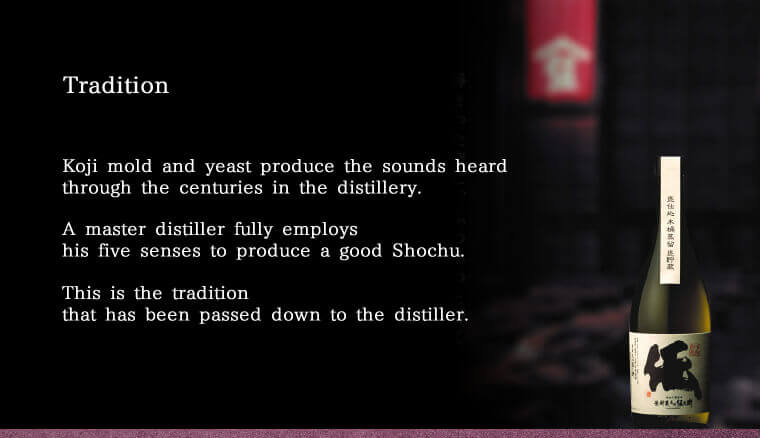
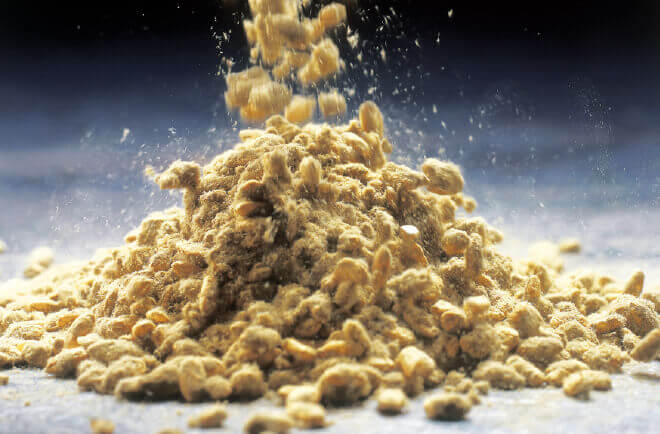
The Yellow koji mold has made a comeback in Shochu making.
Yellow koji mold was once used to make Shochu in Kagoshima. Traditionally, it was the koji mold for sake. But it often caused quality deterioration because of the warm climate of southern Kyushu. Before long, Yellow koji mold was discarded and replaced by Black koji mold and White koji mold because they have a strong resistance against microbes. Yellow koji mold made a comeback at Denbeegura, where Shochu making began with Yellow koji mold as its source. Master distillers brought their sharp senses into full play and brought the traditional taste back to life.
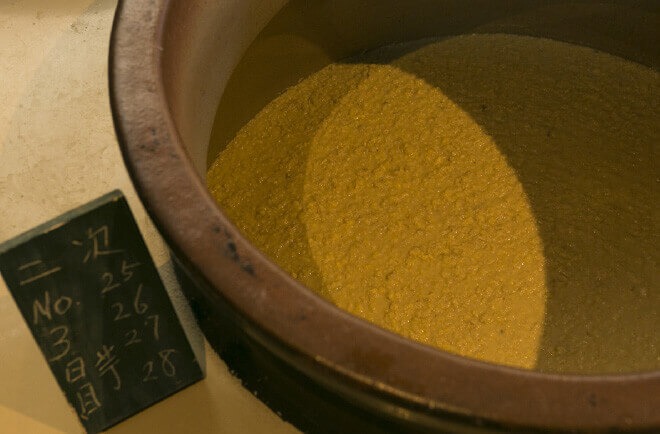
Second moromi fermentation has made Imo Shochu much tastier.
Second moromi fermentation was introduced at the same time as Black koji mold. Before, water, koji mold and sweet potatoes were fermented in a single step. But the new method divided it into two stages: first stage fermentation, where first moromi (fermenting mash) is made, and second moromi fermentation, where sweet potatoes are added as a raw ingredient for further fermentation. Imo Shochu has become much tastier because of the second moromi fermentation, during which steamed sweet potatoes are added after they have become sweeter in the steaming process.
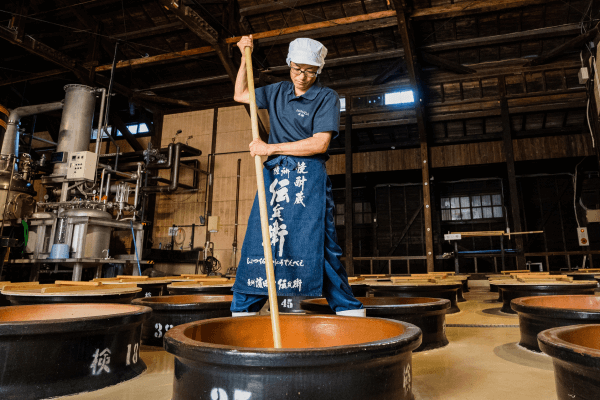
Traditional method of fermentation in the jar was the standard in the Meiji period.
Fermentation and aging in jars is the traditional Shochu making method passed down from the Meiji period. The large jars placed in a long line are more than 100 years old. Master distillers have a firm grasp of the characters of the jars of different ages and sizes. Round-shaped jars have circulation occurring inside, which reduces temperature irregularity during fermentation. Earthen jars emit ultra-red rays, which makes Shochu stored in them milder in taste.
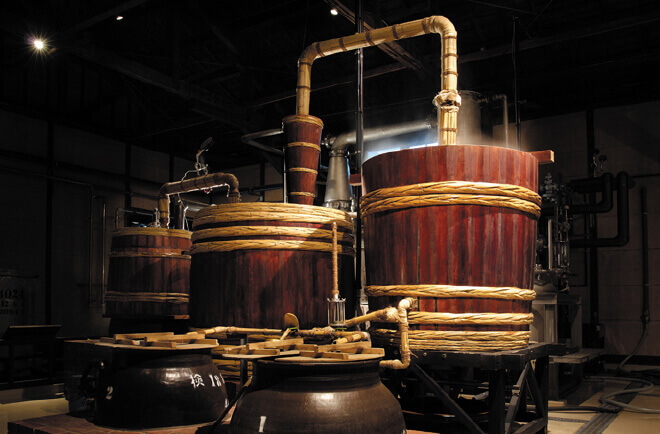
The wooden barrel distiller has been brought back to life to maintain the traditional taste
Widely used from the Edo to Meiji periods, wooden barrel distillers were heated by steam blown into them. Wooden barrel distillers are difficult to maintain because they need repair every few years due to the damaging effect of heat and the acid content of moromi (fermenting mash). Denbeegura has them maintained carefully by the only professional wooden barrel maker remaining in Kagoshima Prefecture. This is done in order to maintain the taste of traditional Satsuma Honkaku Shochu.
The Yellow koji mold has made a comeback in Shochu making.
Yellow koji mold was once used to make Shochu in Kagoshima. Traditionally, it was the koji mold for sake. But it often caused quality deterioration because of the warm climate of southern Kyushu. Before long, Yellow koji mold was discarded and replaced by Black koji mold and White koji mold because they have a strong resistance against microbes. Yellow koji mold made a comeback at Denbeegura, where Shochu making began with Yellow koji mold as its source. Master distillers brought their sharp senses into full play and brought the traditional taste back to life.
Second moromi fermentation has made Imo Shochu much tastier.
Second moromi fermentation was introduced at the same time as Black koji mold. Before, water, koji mold and sweet potatoes were fermented in a single step. But the new method divided it into two stages: first stage fermentation, where first moromi (fermenting mash) is made, and second moromi fermentation, where sweet potatoes are added as a raw ingredient for further fermentation. Imo Shochu has become much tastier because of the second moromi fermentation, during which steamed sweet potatoes are added after they have become sweeter in the steaming process.
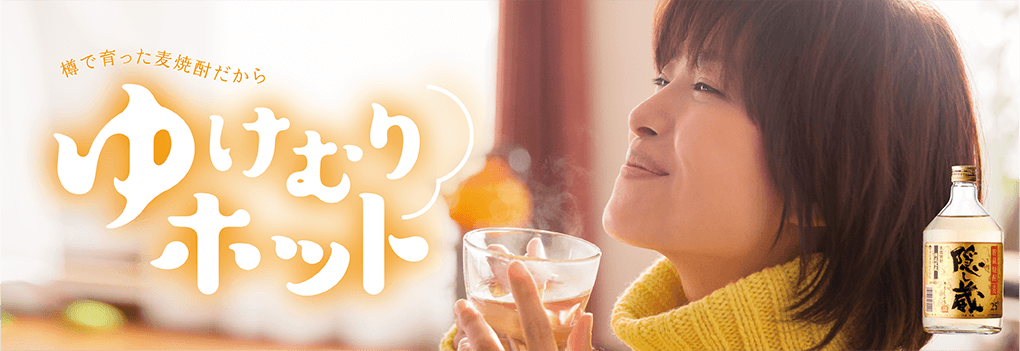
Traditional method of fermentation in the jar was the standard in the Meiji period.
Fermentation and aging in jars is the traditional Shochu making method passed down from the Meiji period. The large jars placed in a long line are more than 100 years old. Master distillers have a firm grasp of the characters of the jars of different ages and sizes. Round-shaped jars have circulation occurring inside, which reduces temperature irregularity during fermentation. Earthen jars emit ultra-red rays, which makes Shochu stored in them milder in taste.
The wooden barrel distiller has been brought back to life to maintain the traditional taste
Widely used from the Edo to Meiji periods, wooden barrel distillers were heated by steam blown into them. Wooden barrel distillers are difficult to maintain because they need repair every few years due to the damaging effect of heat and the acid content of moromi (fermenting mash). Denbeegura has them maintained carefully by the only professional wooden barrel maker remaining in Kagoshima Prefecture. This is done in order to maintain the taste of traditional Satsuma Honkaku Shochu.


The Yellow koji mold has made a comeback in Shochu making.
Yellow koji mold was once used to make Shochu in Kagoshima. Traditionally, it was the koji mold for sake. But it often caused quality deterioration because of the warm climate of southern Kyushu. Before long, Yellow koji mold was discarded and replaced by Black koji mold and White koji mold because they have a strong resistance against microbes. Yellow koji mold made a comeback at Denbeegura, where Shochu making began with Yellow koji mold as its source. Master distillers brought their sharp senses into full play and brought the traditional taste back to life.

Second moromi fermentation has made Imo Shochu much tastier.
Second moromi fermentation was introduced at the same time as Black koji mold. Before, water, koji mold and sweet potatoes were fermented in a single step. But the new method divided it into two stages: first stage fermentation, where first moromi (fermenting mash) is made, and second moromi fermentation, where sweet potatoes are added as a raw ingredient for further fermentation. Imo Shochu has become much tastier because of the second moromi fermentation, during which steamed sweet potatoes are added after they have become sweeter in the steaming process.

Traditional method of fermentation in the jar was the standard in the Meiji period.
Fermentation and aging in jars is the traditional Shochu making method passed down from the Meiji period. The large jars placed in a long line are more than 100 years old. Master distillers have a firm grasp of the characters of the jars of different ages and sizes. Round-shaped jars have circulation occurring inside, which reduces temperature irregularity during fermentation. Earthen jars emit ultra-red rays, which makes Shochu stored in them milder in taste.

The wooden barrel distiller has been brought back to life to maintain the traditional taste
Widely used from the Edo to Meiji periods, wooden barrel distillers were heated by steam blown into them. Wooden barrel distillers are difficult to maintain because they need repair every few years due to the damaging effect of heat and the acid content of moromi (fermenting mash). Denbeegura has them maintained carefully by the only professional wooden barrel maker remaining in Kagoshima Prefecture. This is done in order to maintain the taste of traditional Satsuma Honkaku Shochu.
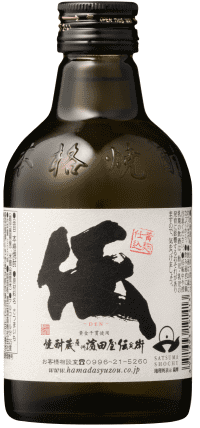
- Alcohol
- 25%
- Container
- Bottle
- Volume
- 300ml

- Alcohol
- 25%
- Container
- Bottle
- Volume
- 720ml

- Alcohol
- 25%
- Container
- Bottle
- Volume
- 1800ml

- Alcohol
- 25%
- Container
- Bottle
- Volume
- 300ml

- Alcohol
- 25%
- Container
- Bottle
- Volume
- 720ml

- Alcohol
- 25%
- Container
- Bottle
- Volume
- 1800ml

